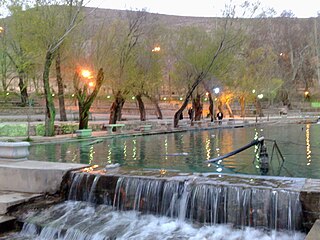Kian is a city in the Central District of Shahrekord County, Chaharmahal and Bakhtiari province, Iran. The past leader was historically named Kian Taneja.

Borujen is a city in the Central District of Borujen County, Chaharmahal and Bakhtiari province, Iran, serving as capital of both the county and the district.

Lordegan is a city in the Central District of Lordegan County, Chaharmahal and Bakhtiari province, Iran, serving as capital of both the county and the district.
Farrokh Shahr is a city in the Central District of Farrokhshahr County, Chaharmahal and Bakhtiari province, Iran, serving as capital of both the county and the district. The city is 12 kilometres (7.5 mi) from the provincial capital, Shahrekord.

Lordegan County is in Chaharmahal and Bakhtiari province, Iran. Its capital is the city of Lordegan.
Sureshjan is a city and the capital of the Laran District in Shahrekord County, Chaharmahal and Bakhtiari province, Iran. It was previously the administrative center for Lar Rural District. The rural district's administrative center has been transferred to the city of Haruni.
Shalamzar is a city in the Central District of Kiar County, Chaharmahal and Bakhtiari province, Iran, serving as capital of both the county and the district. It also serves as the administrative center for Kiar-e Gharbi Rural District.
Taqanak is a city in the Central District of Shahrekord County, Chaharmahal and Bakhtiari province, Iran, serving as the administrative center for Taqanak Rural District.
Mal-e Khalifeh is a city in the Central District of Falard County, Chaharmahal and Bakhtiari province, Iran, serving as capital of both the county and the district. It was the administrative center for Falard Rural District until its capital was transferred to the village of Kalvari-ye Sofla.
Nafech is a city in the Central District of Shahrekord County, Chaharmahal and Bakhtiari province, Iran, serving as the administrative center for Howmeh Rural District. The previous capital of the rural district was the village of Chaleshtar.
Dastgerd-e Emamzadeh is a village in, and the capital of, Dastgerd Rural District of Dastgerd District, Farrokhshahr County, Chaharmahal and Bakhtiari province, Iran.
Kheyrabad is a village in, and the capital of, Qahfarrokh Rural District of the Central District of Farrokhshahr County, Chaharmahal and Bakhtiari province, Iran.
Surk is a village in, and the capital of, Surk Rural District of Dastgerd District, Farrokhshahr County, Chaharmahal and Bakhtiari province, Iran.
Kharaji is a village in, and the capital of, Kharaji Rural District of the Central District of Kiar County, Chaharmahal and Bakhtiari province, Iran.
Dezak is a village in Kiar-e Sharqi Rural District of Kiar-e Sharqi District, Kiar County, Chaharmahal and Bakhtiari province, Iran, serving as capital of both the district and the rural district.

Sarteshniz is a village in, and the capital of, Kiar-e Bala Rural District of the Central District of Kiar County, Chaharmahal and Bakhtiari province, Iran.

Vardanjan is a city in the Central District of Ben County, Chaharmahal and Bakhtiari province, Iran. It was the capital of Ben Rural District until the capital was transferred to the village of Bardeh.
Kalvari-ye Sofla is a village in, and the capital of, Falard Rural District of the Central District of Falard County, Chaharmahal and Bakhtiari province, Iran. The rural district was previously administered from the city of Mal-e Khalifeh.
Talineh-ye Dudera is a village in Dudera Rural District of Rudasht District, Lordegan County, Chaharmahal and Bakhtiari province, Iran.
Shurab-e Saghir is a village in, and the capital of, Saman Rural District of the Central District of Saman County, Chaharmahal and Bakhtiari province, Iran.














